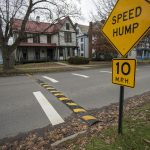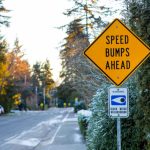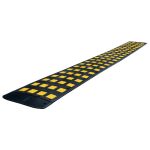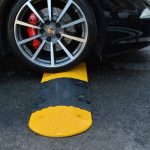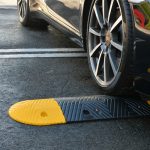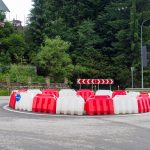Introduction
Definition of speed bumps
A speed bump, also known as a speed hump, is a raised portion of the road surface designed to slow down vehicles. It is typically made of asphalt or concrete and is installed in areas where speed needs to be reduced for safety reasons. Speed bumps are commonly found in parking lots, residential areas, and school zones. They serve as a physical reminder for drivers to reduce their speed and increase awareness of their surroundings. By forcing drivers to slow down, speed bumps help to prevent accidents, improve pedestrian safety, and create a more controlled traffic flow.
Importance of parking lot safety
Parking lot safety is of utmost importance to ensure the well-being of both drivers and pedestrians. One crucial aspect of maintaining a safe parking lot is the installation of speed bumps. Speed bumps play a vital role in reducing the speed of vehicles, thereby minimizing the risk of accidents and collisions. They serve as a visual reminder for drivers to slow down and navigate the parking lot with caution. By effectively slowing down vehicles, speed bumps create a safer environment for pedestrians to cross the parking lot and for drivers to maneuver their vehicles. Additionally, speed bumps also help in preventing reckless driving and encourage responsible behavior among drivers. Overall, the presence of speed bumps in parking lots is essential for enhancing safety and preventing potential hazards.
Overview of the article
In this article, we will explore the importance of speed bumps in ensuring parking lot safety. Speed bumps are an essential feature in parking lots as they help regulate vehicle speed, prevent accidents, and protect pedestrians. By slowing down vehicles, speed bumps encourage drivers to be more cautious and attentive while navigating through parking areas. Additionally, speed bumps serve as a visual cue for drivers to be aware of their surroundings and to yield to pedestrians. Overall, speed bumps play a crucial role in maintaining a safe and secure environment in parking lots, making them an indispensable element of parking lot design and management.
Benefits of Speed Bumps

Slowing down vehicle speed
Slowing down vehicle speed is crucial for maintaining safety in parking lots, and speed bumps play a vital role in achieving this objective. These raised structures are strategically placed to force drivers to reduce their speed, preventing accidents and ensuring the well-being of pedestrians and other vehicles. By inducing a slower pace, speed bumps allow drivers to have better control over their vehicles, enabling them to react promptly to unexpected situations. Moreover, they serve as a visual reminder for drivers to remain cautious and attentive while navigating through the parking lot. Overall, speed bumps are an essential tool in promoting parking lot safety by effectively slowing down vehicle speed.
Reducing accidents and injuries
Reducing accidents and injuries is of paramount importance in any parking lot, and one effective way to achieve this is by installing speed bumps. Speed bumps play a crucial role in slowing down vehicles and ensuring that drivers adhere to the designated speed limits. By forcing drivers to slow down, speed bumps help to minimize the risk of collisions and accidents, making parking lots safer for both pedestrians and vehicles. Additionally, speed bumps also serve as a visual reminder for drivers to exercise caution and be more aware of their surroundings. Overall, the presence of speed bumps in parking lots is essential for enhancing safety and preventing accidents and injuries.
Enhancing pedestrian safety
Enhancing pedestrian safety is a crucial aspect of creating a secure environment in parking lots. One effective measure that can significantly contribute to this goal is the installation of speed bumps. Speed bumps serve as a visual and physical reminder for drivers to slow down and be more cautious while navigating through parking lots. By reducing vehicle speeds, speed bumps help minimize the risk of accidents and collisions involving pedestrians. They create a safer space for pedestrians to walk and cross, ensuring that they are protected from potential harm. Additionally, speed bumps also encourage drivers to be more attentive and aware of their surroundings, further enhancing pedestrian safety in parking lots.
Types of Speed Bumps
Traditional speed bumps
Traditional speed bumps are a common feature in parking lots and are designed to slow down vehicles and ensure the safety of pedestrians. These speed bumps are typically made of rubber or concrete and are strategically placed to force drivers to reduce their speed. By creating a physical barrier on the road, traditional speed bumps effectively prevent speeding and reckless driving in parking lots. They serve as a visual reminder for drivers to exercise caution and be aware of their surroundings, especially in areas where pedestrians may be present. Overall, traditional speed bumps play a crucial role in enhancing parking lot safety and reducing the risk of accidents.
Speed humps
Speed humps, also known as speed bumps, are an important feature in ensuring parking lot safety. These raised structures are designed to slow down vehicles and minimize the risk of accidents. By forcing drivers to reduce their speed, speed humps create a safer environment for pedestrians and other vehicles in the parking lot. They serve as a visual reminder for drivers to be cautious and alert, especially in areas where there is heavy foot traffic. Additionally, speed humps help to control the flow of traffic and encourage drivers to adhere to the designated speed limits. Overall, the presence of speed humps in parking lots plays a crucial role in enhancing safety and preventing potential collisions.
Speed cushions
Speed cushions are a type of traffic calming device that are commonly used in parking lots to enhance safety. These raised platforms are strategically placed along the driving lanes to slow down vehicles and reduce their speed. Unlike traditional speed bumps, speed cushions are designed to allow emergency vehicles and larger vehicles, such as buses, to pass over them more easily. This makes them an effective solution for maintaining a safe and efficient flow of traffic in parking lots. By incorporating speed cushions in parking lot design, businesses and property owners can greatly reduce the risk of accidents and promote a safer environment for pedestrians and drivers alike.
Design Considerations

Proper height and width
Proper height and width of speed bumps play a crucial role in ensuring parking lot safety. These physical barriers are designed to slow down vehicles and enforce traffic regulations. The height of a speed bump should be sufficient enough to grab the attention of drivers and encourage them to reduce their speed. Additionally, the width of a speed bump should be wide enough to accommodate different types of vehicles, including cars, trucks, and motorcycles. By maintaining the proper height and width of speed bumps, parking lot owners can effectively promote safe driving practices and prevent accidents within their premises.
Reflective markings
Reflective markings play a crucial role in enhancing the effectiveness of speed bumps in parking lots. These markings, typically made of reflective materials, are strategically placed on the surface of the speed bumps to ensure maximum visibility, especially during low light conditions. By reflecting light from headlights, these markings alert drivers to the presence of speed bumps, allowing them to slow down and navigate the parking lot with increased caution. Moreover, the use of reflective markings also helps pedestrians and other road users to easily identify the location of speed bumps, reducing the risk of accidents and promoting overall safety. In essence, reflective markings serve as a visual warning system that significantly contributes to the effectiveness of speed bumps in improving parking lot safety.
Placement and spacing
Placement and spacing of speed bumps in parking lots play a crucial role in ensuring the safety of both pedestrians and vehicles. When strategically positioned, speed bumps help control the flow of traffic and reduce the risk of accidents by slowing down vehicles to a safe speed. It is important to place speed bumps at appropriate intervals to maintain a consistent speed limit throughout the parking lot. Additionally, proper placement of speed bumps can help prevent unauthorized speeding or reckless driving, creating a safer environment for everyone. By carefully considering the placement and spacing of speed bumps, parking lot owners can effectively enhance the overall safety and security of their facilities.
Installation Process

Preparation of the parking lot
Preparation of the parking lot is a crucial step in ensuring the safety and efficiency of any parking facility. One important aspect of this preparation is the installation of speed bumps. Speed bumps play a vital role in slowing down vehicles and enforcing lower speeds within the parking lot. By strategically placing speed bumps at appropriate intervals, drivers are compelled to reduce their speed, reducing the risk of accidents and promoting a safer environment for pedestrians. Additionally, speed bumps help to maintain order and prevent reckless driving, ensuring that all vehicles navigate the parking lot responsibly. Overall, the proper preparation of a parking lot includes the installation of speed bumps as an essential measure to enhance parking lot safety.
Installation of speed bumps
The installation of speed bumps is a crucial aspect of ensuring parking lot safety. Speed bumps are designed to slow down vehicles and enforce a reduced speed limit in parking areas. By strategically placing speed bumps throughout the parking lot, drivers are forced to slow down, reducing the risk of accidents and promoting pedestrian safety. Additionally, speed bumps act as a visual reminder for drivers to be cautious and attentive while navigating the parking lot. The installation process involves carefully measuring and marking the desired locations for the speed bumps, followed by the construction and placement of the bumps. Proper installation ensures that the speed bumps are effective in controlling speed and enhancing overall safety in parking lots.
Maintenance and repair
Maintenance and repair are crucial aspects of ensuring the effectiveness and longevity of speed bumps in parking lots. Regular maintenance activities such as inspecting for any signs of damage or wear, cleaning off debris, and repainting the speed bumps can help maintain their visibility and functionality. Additionally, prompt repair of any damages, such as cracks or loose bolts, is essential to prevent potential hazards and maintain a safe environment for drivers and pedestrians. By prioritizing maintenance and repair, parking lot owners can ensure that speed bumps continue to play a vital role in enhancing safety and reducing speeding incidents.
Controversies and Challenges

Impact on vehicle suspension
Speed bumps have a significant impact on the suspension of vehicles. These raised structures are designed to slow down vehicles and ensure safety in parking lots. However, the abrupt change in elevation can cause stress on the suspension system of cars, leading to potential damage over time. The repeated jolts experienced by the suspension components can result in wear and tear, affecting the overall performance and longevity of the vehicle’s suspension. It is important for drivers to be aware of the potential impact on their vehicle’s suspension and take necessary precautions, such as reducing speed and avoiding sudden acceleration or braking when encountering speed bumps.
Resistance from drivers
Resistance from drivers is a common challenge when it comes to implementing speed bumps in parking lots. Many drivers argue that speed bumps are unnecessary and inconvenient. They believe that speed bumps slow down traffic flow and cause discomfort for passengers. Some drivers even go as far as avoiding parking lots with speed bumps altogether. However, it is important to recognize that speed bumps play a crucial role in ensuring parking lot safety. They help to control and reduce speed, preventing accidents and protecting pedestrians. Despite the resistance from drivers, it is essential to prioritize safety and implement speed bumps in parking lots.
Legal and liability issues
Legal and liability issues surrounding the installation of speed bumps in parking lots are of utmost importance. It is crucial for property owners and managers to understand the legal implications and potential liabilities associated with these traffic calming measures. While speed bumps are effective in reducing speeding and enhancing safety, they must be installed in compliance with local laws and regulations. Failure to do so can result in legal consequences and financial liability for the property owner. Additionally, it is essential to consider the potential impact on drivers and pedestrians, as improper installation or maintenance of speed bumps can lead to accidents and injuries. Therefore, thorough research, consultation with legal experts, and adherence to safety guidelines are essential when implementing speed bumps in parking lots.


